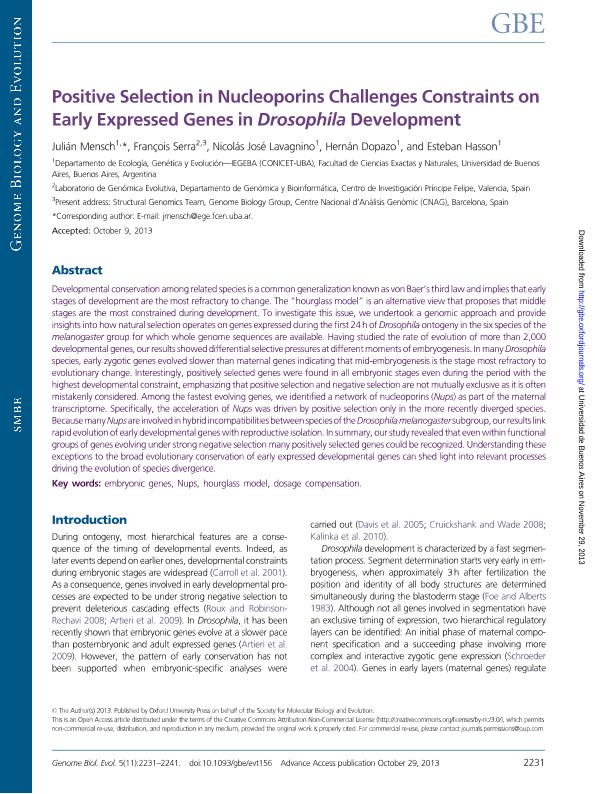Mostrar el registro sencillo del ítem
dc.contributor.author
Mensch, Julian

dc.contributor.author
Serra, François
dc.contributor.author
Lavagnino, Nicolas Jose

dc.contributor.author
Dopazo, Hernán Javier

dc.contributor.author
Hasson, Esteban Ruben

dc.date.available
2017-04-28T21:29:45Z
dc.date.issued
2013-10
dc.identifier.citation
Mensch, Julian; Serra, François; Lavagnino, Nicolas Jose; Dopazo, Hernán Javier; Hasson, Esteban Ruben; Positive selection in Nucleoporins challenges constraints on early expressed genes in Drosophila development; Oxford University Press; Genome Biology and Evolution; 5; 11; 10-2013; 2231-2241
dc.identifier.uri
http://hdl.handle.net/11336/15851
dc.description.abstract
Developmental conservation among related species is a common generalization known as von Baer’s third law and implies that early stages of development are the most refractory to change. The “hourglass model” is an alternative view that proposes that middle stages are the most constrained during development. To investigate this issue, we undertook a genomic approach and provide insights into how natural selection operates on genes expressed during the first 24 h of Drosophila ontogeny in the six species of the melanogaster group for which whole genome sequences are available. Having studied the rate of evolution of more than 2,000 developmental genes,ourresults showed differential selective pressures atdifferentmoments ofembryogenesis. In manyDrosophila species, early zygotic genes evolved slower than maternal genes indicating that mid-embryogenesis is the stage most refractory to evolutionary change. Interestingly, positively selected genes were found in all embryonic stages even during the period with the highest developmental constraint, emphasizing that positive selection and negative selection are not mutually exclusive as it is often mistakenly considered. Among the fastest evolving genes, we identified a network of nucleoporins (Nups) as part of the maternal transcriptome. Specifically, the acceleration of Nups was driven by positive selection only in the more recently diverged species. BecausemanyNupsareinvolvedinhybridincompatibilitiesbetweenspeciesoftheDrosophilamelanogastersubgroup,ourresultslink rapid evolution of early developmental genes with reproductive isolation. In summary, our study revealed that even within functional groups of genes evolving under strong negative selection many positively selected genes could be recognized. Understanding these exceptions to the broad evolutionary conservation of early expressed developmental genes can shed light into relevant processes driving the evolution of species divergence.
dc.format
application/pdf
dc.language.iso
eng
dc.publisher
Oxford University Press

dc.rights
info:eu-repo/semantics/openAccess
dc.rights.uri
https://creativecommons.org/licenses/by-nc-sa/2.5/ar/
dc.subject
Embryonic Genes
dc.subject
Nups
dc.subject
Hourglass Model
dc.subject
Dosage Compensation
dc.subject.classification
Genética y Herencia

dc.subject.classification
Ciencias Biológicas

dc.subject.classification
CIENCIAS NATURALES Y EXACTAS

dc.title
Positive selection in Nucleoporins challenges constraints on early expressed genes in Drosophila development
dc.type
info:eu-repo/semantics/article
dc.type
info:ar-repo/semantics/artículo
dc.type
info:eu-repo/semantics/publishedVersion
dc.date.updated
2017-04-28T20:28:13Z
dc.identifier.eissn
1759-6653
dc.journal.volume
5
dc.journal.number
11
dc.journal.pagination
2231-2241
dc.journal.pais
Reino Unido

dc.journal.ciudad
Oxford
dc.description.fil
Fil: Mensch, Julian. Consejo Nacional de Investigaciones Científicas y Técnicas. Oficina de Coordinación Administrativa Ciudad Universitaria. Instituto de Ecología, Genética y Evolución de Buenos Aires. Universidad de Buenos Aires. Facultad de Ciencias Exactas y Naturales. Instituto de Ecología, Genética y Evolución de Buenos Aires; Argentina
dc.description.fil
Fil: Serra, François. Centro de Investigaciones Principe Felipe; España. Centro Nacional de Análisis Genómico; España
dc.description.fil
Fil: Lavagnino, Nicolas Jose. Consejo Nacional de Investigaciones Científicas y Técnicas. Oficina de Coordinación Administrativa Ciudad Universitaria. Instituto de Ecología, Genética y Evolución de Buenos Aires. Universidad de Buenos Aires. Facultad de Ciencias Exactas y Naturales. Instituto de Ecología, Genética y Evolución de Buenos Aires; Argentina
dc.description.fil
Fil: Dopazo, Hernán Javier. Consejo Nacional de Investigaciones Científicas y Técnicas. Oficina de Coordinación Administrativa Ciudad Universitaria. Instituto de Ecología, Genética y Evolución de Buenos Aires. Universidad de Buenos Aires. Facultad de Ciencias Exactas y Naturales. Instituto de Ecología, Genética y Evolución de Buenos Aires; Argentina
dc.description.fil
Fil: Hasson, Esteban Ruben. Consejo Nacional de Investigaciones Científicas y Técnicas. Oficina de Coordinación Administrativa Ciudad Universitaria. Instituto de Ecología, Genética y Evolución de Buenos Aires. Universidad de Buenos Aires. Facultad de Ciencias Exactas y Naturales. Instituto de Ecología, Genética y Evolución de Buenos Aires; Argentina
dc.journal.title
Genome Biology and Evolution
dc.relation.alternativeid
info:eu-repo/semantics/altIdentifier/doi/http://dx.doi.org/10.1093/gbe/evt156
dc.relation.alternativeid
info:eu-repo/semantics/altIdentifier/url/https://academic.oup.com/gbe/article-lookup/doi/10.1093/gbe/evt156
dc.relation.alternativeid
info:eu-repo/semantics/altIdentifier/url/https://www.ncbi.nlm.nih.gov/pmc/articles/PMC3845637/
Archivos asociados
